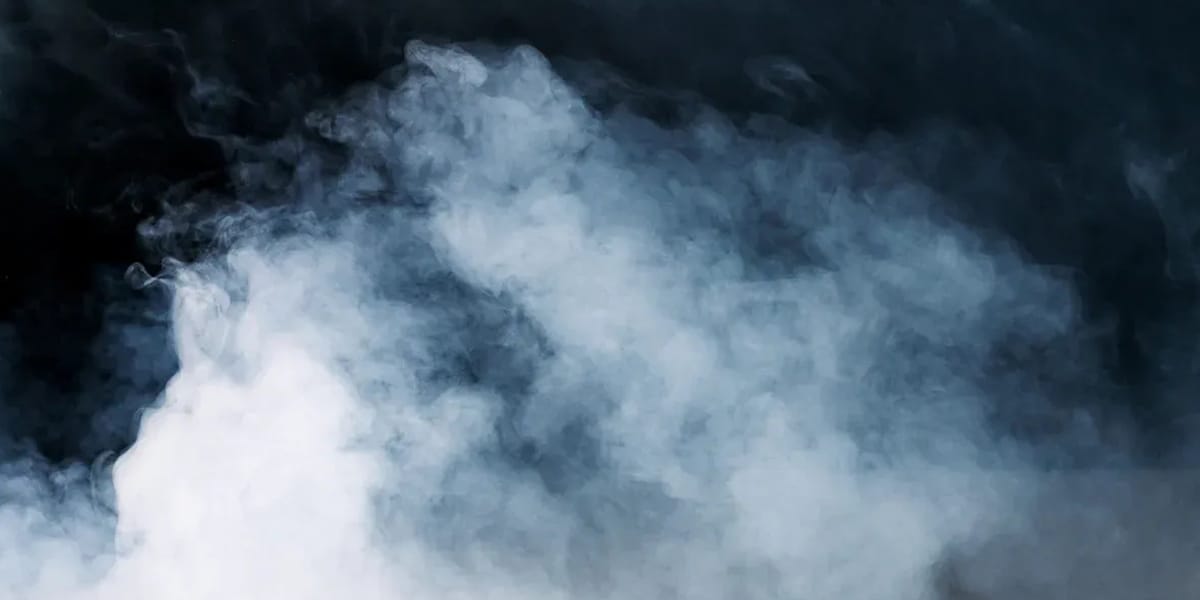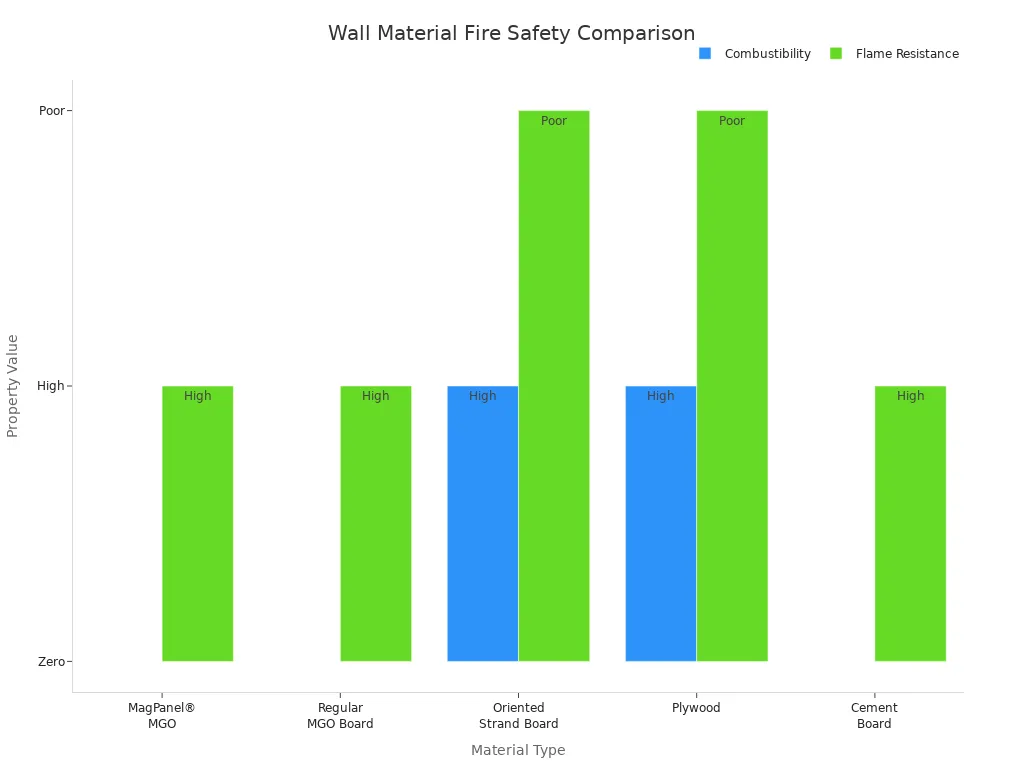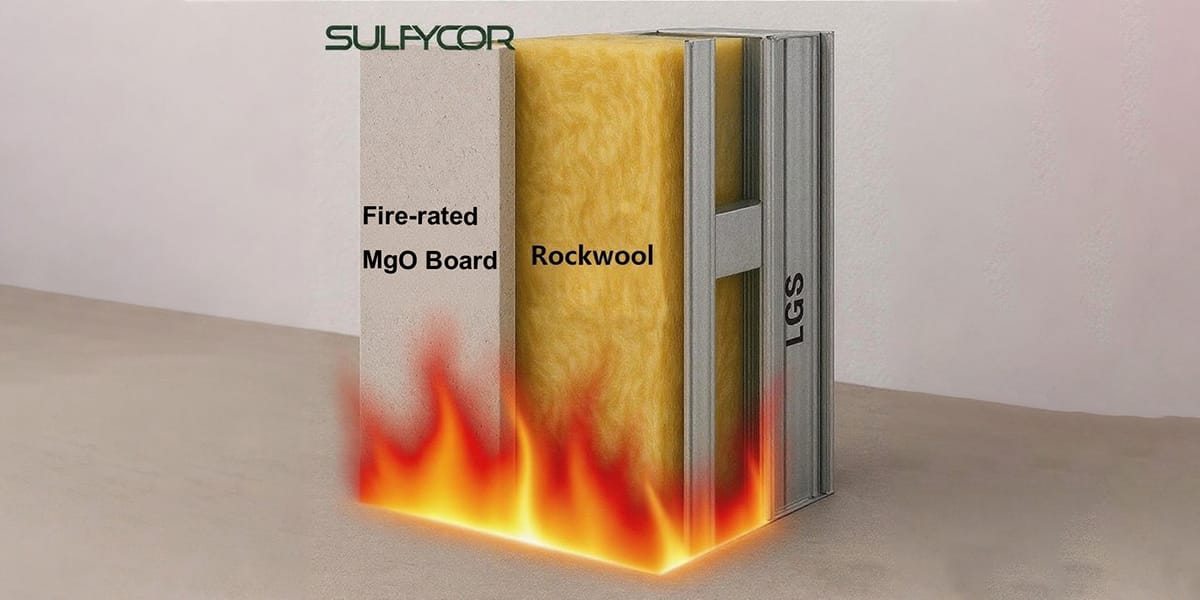
21 Aug Whether Magnesium Wall Board Releases Toxic Gases When On Fire
Table of Contents
- 1 Key Takeaways
- 2 Fire Performance
- 3 Toxicity and Smoke Emission
- 4 Material Comparison
- 5 Certifications and Test Results
- 6 FAQ
- 6.1 What makes magnesium wall board a good fire-resistant building material?
- 6.2 Does magnesium oxide board release toxic gases or fumes during a fire?
- 6.3 How does magnesium wall board help with reduced smoke and toxicity?
- 6.4 Can magnesium wall board be used in fire-resistant panels for high-risk areas?
- 6.5 Why is the importance of fire-resistant building materials so high for health and safety?
Magnesium wall board does not give off toxic gases in a fire. This material does not burn and keeps air safe inside. New magnesium wall boards use magnesium sulfate, not magnesium chloride. This change stops problems like swelling and mold. Some people worry about fire safety because of old problems. But these boards now follow strict world rules. Fire-resistant building materials do more than protect property. They also help keep people healthy and calm.
Key Takeaways
Magnesium wall board does not burn in a fire. It does not let out toxic gases. This makes it very safe for buildings and people. – This board can handle heat up to 1200°C. It makes very little smoke. This helps keep the air clean in emergencies. – Magnesium wall board is better than wood, gypsum, and cement boards. It has stronger fire resistance. It also gives off less smoke and toxins. – Magnesium wall board meets tough fire safety rules everywhere. It gets top marks for stopping flames and smoke. – Using magnesium wall board helps keep people healthy. It lowers fire risks. It also helps the environment.
Fire Performance
Non-Combustibility of Magnesium Wall Board
Magnesium wall board does not burn in a fire. Magnesium oxide makes the board very hard to catch fire. Even strong flames cannot make it burn. Magnesium oxide is the main part and keeps the board strong. Glass fibers and silica are added to make it tougher and stable in heat. The way the board is made helps it handle heat and stress better.
Magnesium wall board blocks fire and stops flames from moving.
Magnesium oxide board does not help fires grow, so it keeps fire in one place.
The table below shows how different wall materials react to fire:
Material Type | Combustibility | Flame Resistance |
|---|---|---|
MagPanel® MGO (magnesium sulfate) | Zero | High |
Regular MGO Board (magnesium chloride) | Zero | High |
Oriented Strand Board (OSB) | High | Poor |
Plywood | High | Poor |
Cement Board | Zero | High |

Behavior Under High Heat
Magnesium wall board works well when it gets very hot. Magnesium oxide can take heat up to 1200°C and does not burn or make toxic gases. Fire tests show these boards stay strong for four hours. They get top fire safety scores like Class A for stopping flames and smoke. Magnesium oxide takes in heat and lets out water vapor. This water vapor mixes with gases and lowers smoke. When the board breaks down, it makes a hard layer that protects the wall and helps people get out safely.
Magnesium wall board does not burn, so it makes little smoke and no toxic gases.
Its fireproof features keep hallways clear and air clean.
Magnesium oxide board is used in panels for buildings that need high fire safety.
Magnesium wall board does not burn and stops fire from spreading. These features help keep people safe and protect buildings by lowering smoke and stopping fire.
Toxicity and Smoke Emission
Toxin-Free During Fires
Magnesium wall board is safe during fires. It does not give off toxins. Magnesium oxide is the main part of the board. It does not burn or make harmful stuff. Even in high heat, it does not let out toxic gases, formaldehyde, or VOCs. This makes it safer than many other building materials.
Magnesium oxide board can take heat up to 1200°F. Its melting point is close to 2800°C.
The board does not make toxic smoke or bad fumes, even in big fires.
It passes tough fire safety rules like China’s GB50016-2014, ASTM E119, and ANSI/UL 263.
It has certifications like ESL-1290 for fire resistance up to two hours.
Lab tests on over 1,000 samples in two years show the board stays strong in fire. The binder in the board turns into magnesium oxide when hot. This makes it even better at stopping fire. Hydrated minerals in the board let out water when heated. This helps slow fire and cuts down smoke. Magnesium wall board does not add toxic smoke, so it is safer for indoor air.
Magnesium oxide board is safer than resin particle boards. It does not make toxic gases or fumes in a fire. This helps keep people in buildings healthier.
No Harmful Gases or VOCs
Magnesium oxide mixes with water to make magnesium hydroxide. When it gets hot, magnesium hydroxide lets out only water vapor. This is why magnesium wall board does not make bad gases or fumes when burning. The water vapor helps slow fire and lowers smoke.
Aspect | Magnesium Oxide (MgO) Board | Particle Board |
|---|---|---|
Combustibility | Non-combustible, lasts in fire up to 4 hours | Burns easily, fire resistance less than 1 hour |
Smoke Emission | Makes very little smoke in fire | Makes a lot of smoke and toxic fumes |
Toxic Chemicals | No formaldehyde or VOCs, no bad chemicals | Has urea-formaldehyde resin that lets out formaldehyde and VOCs that can hurt lungs and cause cancer |
Health Risk from Smoke | Low risk because smoke is not toxic | High risk because smoke is toxic |
Magnesium oxide board only gives off water vapor in fire. So, there are no toxic gases, no bad fumes, and no VOCs in the air. Less smoke and no toxins help protect people from breathing problems. Particle board gives off toxic gases and is more dangerous. Magnesium wall board is much safer.
Magnesium oxide board is also good for the environment. It does not burn or make toxic gases in fire. The board stays strong and protects for up to four hours. It makes very little smoke and no toxic gases, so it is safer for people and nature.
Magnesium oxide board is made from natural minerals and has a low carbon footprint. It can be recycled and does not fill up landfills, which is good for green building.
Magnesium wall board is safe in fires. It does not let out toxic gases, fumes, or VOCs. Only water vapor comes out, so it is one of the safest choices for fire-resistant buildings.
Material Comparison
 Magnesium Wall Board vs. Gypsum
Magnesium Wall Board vs. Gypsum
Magnesium oxide is a great fire-resistant material. It is better than gypsum boards in a fire. Magnesium oxide does not burn at all. It stays strong even when it gets very hot. Gypsum boards can get soft and weak from heat. Both types of boards can stop fire, but magnesium oxide is safer.
Property | Magnesium Oxide (MgO) Boards | Gypsum Boards |
|---|---|---|
Combustibility | Non-combustible; does not burn | Combustible; softens under high heat |
Smoke Emissions | Minimal smoke | Moderate smoke |
Toxic Gas Emissions | No toxic gases emitted | Emits non-toxic gases |
Fire Resistance Rating | Fire-resistant with limited duration |
Magnesium oxide boards make almost no smoke or gas in a fire. This keeps people inside safer. Gypsum boards can let out some gases, but these are not harmful. Still, magnesium oxide boards give more safety.
Magnesium Oxide Board vs. Cement Board
Magnesium oxide boards and cement boards both resist fire. But magnesium oxide boards work better in very hot fires. They stay strong and do not change shape after hours of fire. Cement boards can stop fire but may need extra help in risky places.
Property | Magnesium Oxide (MgO) Boards | Cement Boards |
|---|---|---|
Fire Resistance Rating | Moderate fire resistance; may require additional fireproofing | |
Combustibility | Non-combustible | Non-combustible |
Performance in High Heat | Maintains strength and integrity under extreme heat | May degrade or require extra support under extreme heat |
Smoke and Toxic Gas Emissions | Low emissions; safer during fires | Low emissions but generally less optimal than MgO boards |
Suitability for High Fire Risk Areas | Recommended due to superior fire resistance and stability | Suitable for lower fire risk or moderate fire safety needs |
Magnesium oxide boards do not let out bad gases or lose their shape. They also do not get ruined by water or mold after a fire. Cement boards are good in many places, but magnesium oxide boards are best for high fire risk.
Wood and Smoke Production
Wood is used a lot in buildings, but it is not good in fires. Wood burns fast and makes lots of smoke and toxic fumes. Magnesium oxide boards do not burn and make very little smoke.
Material Type | Smoke Production During Fire |
|---|---|
Magnesium Oxide (MgO) Boards | Very low smoke and toxic fumes; non-combustible |
Wood | High smoke and toxic fumes; combustible, releases carbon and harmful chemicals |
Magnesium oxide boards pass many fire tests. They do not have bad things like formaldehyde or crystalline silica. They also do not get moldy or attract bugs. These things make magnesium oxide boards safer and healthier than wood or other old materials.
Magnesium oxide boards are made from natural things. They can be recycled and are good for the planet. They do not burn or make toxins, so they are one of the best fire-resistant materials for new buildings.
Certifications and Test Results
Fire Safety Standards
Many countries have tough rules for testing wall boards in fires. These rules help builders pick safe materials for homes and offices. The most important certifications are:
Certification | Description | Region/Standard |
|---|---|---|
GB8624 | A1-grade non-combustible classification showing non-flammability | China |
CE12467 | European certification for fiber cement boards, ensuring fire resistance and durability | Europe |
CE14306 | European certification for calcium silicate boards, covering fire safety and insulation | Europe |
AS-NZS2908 | Certification for fire safety in Australia and New Zealand | Australia & New Zealand |
BS476 | UK standard for fire resistance testing of building materials | United Kingdom |
These certifications prove a wall board can handle fire and keep people safe. Some panels get a Class A fire rating. This means flames move very slowly or even stop. Builders use Class A panels in places with more fire danger, like kitchens or hallways. If a product meets these rules, it helps make buildings safer.
Laboratory Findings on Toxicity
Lab tests check if wall boards let out bad gases in a fire. Scientists use special tools to measure gases like carbon monoxide and nitric oxide. In one test, they burned particleboard covered with magnesium compounds. When more magnesium was added, fewer toxic gases came out. Carbon monoxide went down from 1302 ppm to 1091 ppm. Nitric oxide dropped from 415 ppm to 290 ppm. This means magnesium helps lower dangerous gases.
Magnesium oxide boards also go through tests like ASTM E84. These tests look at how fast flames move and how much smoke forms. The results show a flame spread rating of 0/0. This means no flames spread and no smoke is made. The boards do not burn, even at 800°C. This proves they do not let out toxic gases in a fire.
Some labs found that not every magnesium wall board passes all fire tests. Boards with too much organic stuff may not meet the hardest rules. Still, most magnesium wall boards are better at stopping fire than gypsum boards. Their great fire ratings make them a smart pick for safe buildings.
Magnesium wall boards do not catch fire or let out toxic gases. They can handle heat up to 1200°C, which is much hotter than most fires. This makes them safer than drywall or plywood. Experts say to use them in places like schools and hospitals. These boards are strong and do not get damaged by water. They help keep buildings and people safe. Picking magnesium wall boards helps make spaces healthier and safer for all.
FAQ
What makes magnesium wall board a good fire-resistant building material?
Magnesium wall board does not burn in a fire. It does not help flames move. This keeps buildings and people safer. Builders pick it because it does not catch fire. It also gets great fire safety scores.
Does magnesium oxide board release toxic gases or fumes during a fire?
Magnesium oxide board does not make toxic gases or fumes. It stays safe when there is a fire. Only water vapor comes out, so the air stays clean. This helps keep people healthy inside.
How does magnesium wall board help with reduced smoke and toxicity?
Magnesium wall board makes very little smoke in a fire. It does not add toxic stuff to the air. Less smoke and no toxins help people see and breathe better.
Can magnesium wall board be used in fire-resistant panels for high-risk areas?
Yes, magnesium wall board is used in fire-resistant panels. Its fireproof features make it good for places with more fire danger. It helps stop fire from spreading.
Why is the importance of fire-resistant building materials so high for health and safety?
Fire-resistant materials like magnesium wall board lower the risk of bad gases. They help stop fires from moving fast. This keeps people safe and makes buildings healthier.

 Magnesium Wall Board vs. Gypsum
Magnesium Wall Board vs. Gypsum